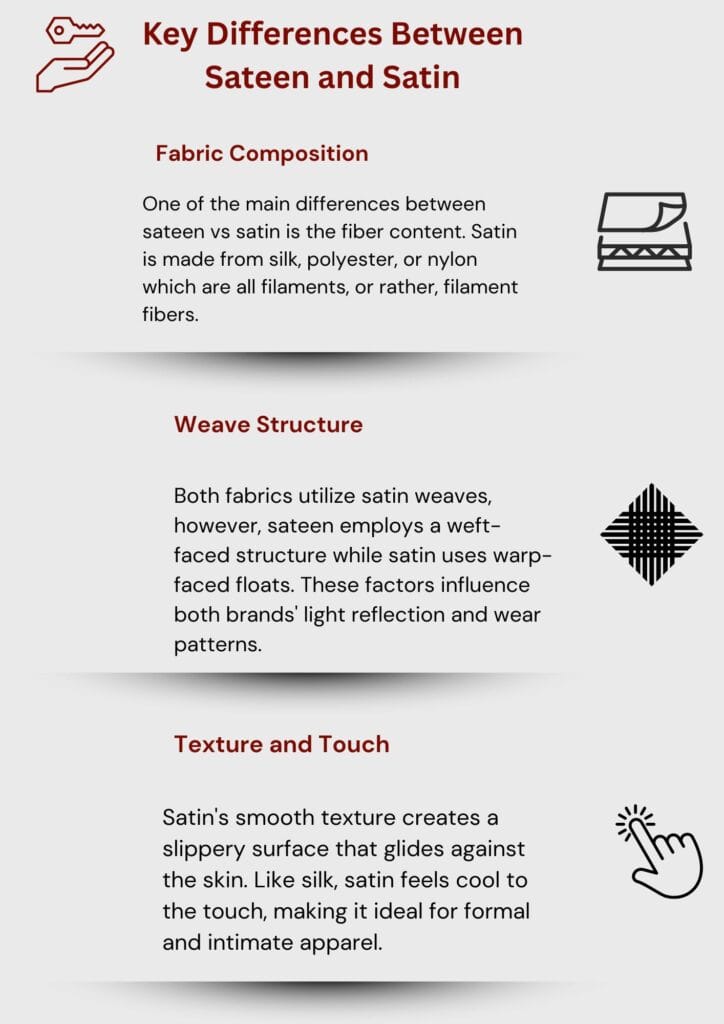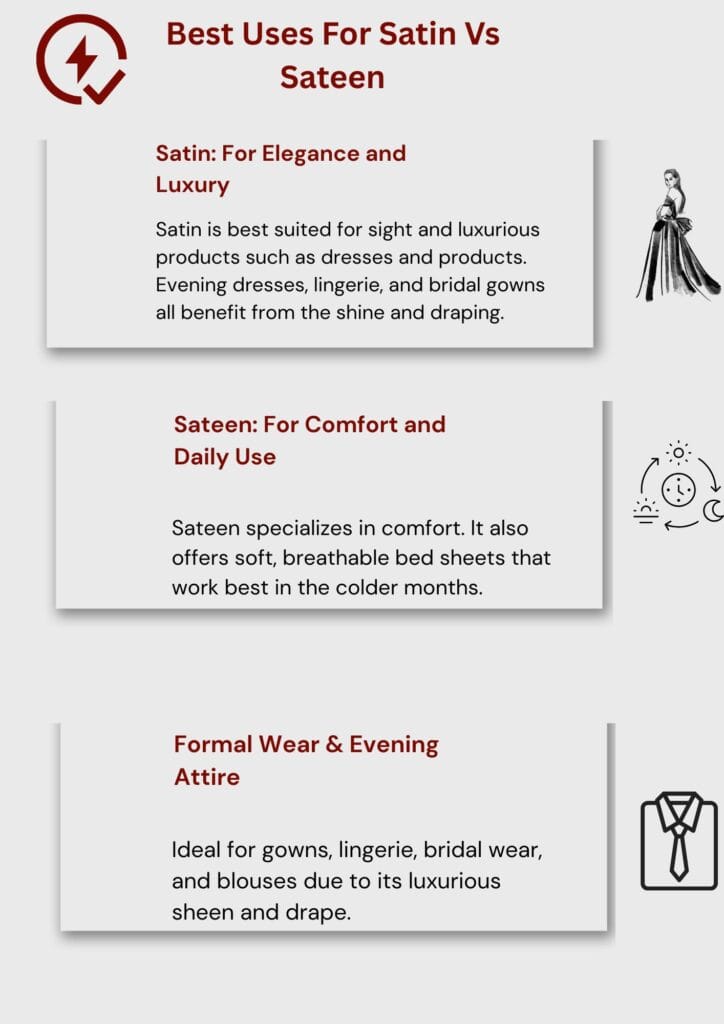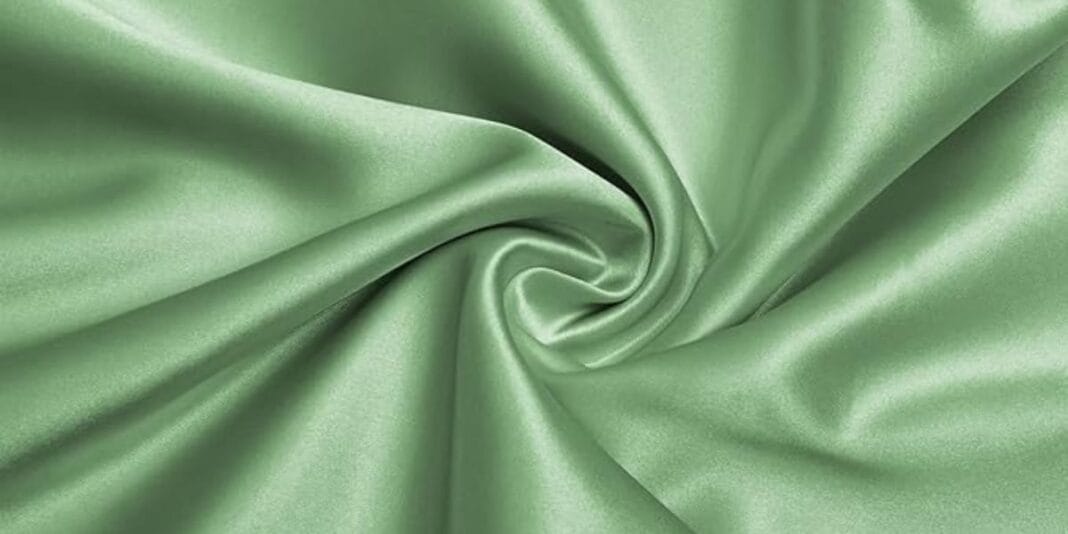Introduction
Satin and sateen are two fabrics that are regularly confused with one another. Sateen and satin fabrics are smooth and elegant. They provide a stylish finish, which is a major reason why they are popular for clothing and bedding. Even though they share an elegant appearance, their composition, weave, texture, and use differ greatly.
The similarities in the names, satin and sateen, along with their glossy finishes and soft textures, are the reason why so many people get confused. The construction and feel tell a whole different story. The most important factors a person needs to keep in mind while choosing a fabric include the comfort, climate, and budget.
In this article, we will analyze and compare both satin and sateen. We will explain the concepts and also present their advantages and disadvantages so that you can make an informed decision according to your requirements.
What is Satin?
Definition and Origin
Satin is a weave, it is not a fabric in its own. Silk was used for making satin traditionally which gave it a high gloss finish and a fluid drape. Nowadays, satin can be made from silk, polyester, or even Nylon. It is suithable made from blends of these. Its origins are traced to China and Middle east where it was considered a luxurious fabric.
Weave Type
Satin employs a type of weaving called satin weave, commonly 4-harness or 8-harness. In these types, the threads float over several others before going under, resulting in a smooth and shiny top surface.
Characteristics
The most distinguishing features of satin is its luster and gloss on the surface, with a matte finish on the underside. It drapes well, feeling cool to the touch and gliding effortlessly over skin, which makes it a popular choice for luxury garments. Moreover, the smooth finish helps reduce friction which is beneficial for hair and skin.
Common uses
Owing to its elegance, satin is frequently used for lingerie, evening gowns, wedding dresses, and high-end bedding. Luxury furniture upholstery may also use satin because of its lustrous beauty and rich texture.
What is sateen?
Definition
Sateen is a fabric woven liket to satin but made from cotton. While satin focuses on sheen, most emphasize softness. It’s a version of sateen made from cotton, rendering it more breathable and easier to wear.
Weave Type
Like satin, sateen uses a weft faced satin weave, usually a 4 harness. However, because sateen is made from spun yarns rather than filament yarns, the final product has softer, subtler sheen, and is heavy.
Characteristics
Sateen has a soft feel and a matte-like finish. While more durable and less prone to wrinkling, it does not glide as easily as satin and is considerably heavier. Many people enjoy the fabric’s warm and cozy hand feel, particularly in colder climates.
Common Uses
You can find sateen in most bedding items like sheets and duvet covers. It is also used in casual shirts and dresses as well as drapery. Sateen’s durability and softness make it ideal for day-to-day wear
Key Differences Between Sateen and Satin

Fabric Composition
One of the main differences between sateen vs satin is the fiber content. Satin is made from silk, polyester, or nylon which are all filaments, or rather, filament fibers. Sateen’s fibers are almost always made of cotton also known as staple fibers. Thus the difference in texture, breathability and price.
Weave Structure
Both fabrics utilize satin weaves, however, sateen employs a weft-faced structure while satin uses warp-faced floats. These factors influence both brands’ light reflection and wear patterns. While satin shines owing to its longer floats, the latter makes the fabric prone to snagging.
Texture and Touch
Satin’s smooth texture creates a slippery surface that glides against the skin. Like silk, satin feels cool to the touch, making it ideal for formal and intimate apparel. Sateen is softer, warmer, and slightly thicker, providing more comfort, which is perfect for casual wear and bedding.
Shine & Visual Characteristics
Satin has a bright, high-gloss satin finish with dramatic capture and reflection of light. Sateen has a more muted, gentle and subtle sheen. If shine is vital, satin wins, but for a softer glow, sateen is a better choice.
Strength & Maintenance
Due to its cotton base, sateen is more durable. It can take machine washes and regular use. Silk satin needs to be handwashed or drycleaned and damages easily. Sateen is therefore more versatile and better for everyday items.
Breathability
Sateen is more absorbent and breathable, which is best for warm sleepers. Satin tends to trap heat less and feel cooler at first, which some people prefer during summer. However, its synthetic versions may not provide adequate breathability.
Sateen can be cheaper than other luxury fabrics. Price wise, pure silks satin is much more expensive as compared to other types of fabrics. Moreover satin is cheaper than silk as its synthetic version is easily available.
Advantages and Disadvantages of Satin
Advantages ✅
- It looks good and feels wonderful and easy to wear: its luxurious feel invokes high-end sensations perfect for special events.
- Cooling Effect: Excellent for those warm summer nights or humid weather.
- Friendly for Hair and Skin: Much less friction means sleep wrinkles and frizzy hair are not an issue
Disadvantages❌
- Snags Easily: The delicate weave can easily be caught on jewelry or nails.
- Care Instructions: Certain items made out of satin need to be hand washed or dry cleaned.
- Less Breathable: More so with satin made out of synthetic fibers which retain heat and moisture.
Pros and Cons of Sateen
Pros ✅
- Durability: Greater resistance to wear makes it ideal for everyday use.
- Increased Softness: For those that appreciate soft touch fabrics, it’s like receiving a warm hug which is very enjoyable on colder days.
- Post-wash shape recovery: Better than with satin, makes the fabric look very sharp.
Cons ❌
- Less dramatic shine: Does not have the dramatic luster of satin.
- Heat Retention: A hot day can feel muggy and sticky outside.
Best Uses For Satin Vs Sateen

Satin: For Elegance and Luxury
Satin is best suited for sight and luxurious products such as dresses and products. Evening dresses, lingerie, and bridal gowns all benefit from the shine and draping. Satin is very useful in the making of pillows because it reduces friction with skin and hair, therefore making a person sleep better.
Sateen: For Comfort and Daily Use
Sateen specializes in comfort. It also offers soft, breathable bed sheets that work best in the colder months. Sateen is also present in casual apparel like skirts and button up shirts due to its comfort and ease.
Which One Should You Choose?
For Bedding
Choose sateen if softness combined with durability is ease of maintenance. It is breathable and easier to care for. The cozier satin bedding is much more luxurious and cooling, but requires more work to maintain.
For Clothing
Opt for satin for formal wears like gowns, slips, and upscale tops. For casual clothing, sateen works best because comfort takes priority. Its cotton base makes it more lightweight, easier to wear, and easy to clean.
Budget Considerations
Sateen is more affordable, especially since it’s cotton-based. High-end satin, particularly silk satin, can be costly. Cheaper synthetic satin lacks breathability.
Conclusion
Knowing the key differences between sateen and satin sates you makes the difference for your clothing and home. Even though most people think it’s the same, both serve different purposes.
Satin is great for luxury apparel such as elegant dresses, feminine lingerie and beauty pillow cases due to it’s glossy sheen. It adds a sense of rich glamor giving cool comfort, but requires careful handling. Sateen on the other hand is soft, warm and durable. Because it is made of cotton, it is easier to care for making it ideal for casual clothing as well as multiuse everyday bedding.
FAQs
They are not the same. While they share a weave pattern, satin is usually silk or synthetic based and sateen is cotton based. The two differ greatly in feel, look, and performance.
Sateen is the winner when it comes to moisture-wicking and breathability making it useful for those who will sleep hotter. However, if the satin is preferred, it will be most beneficial during mild cold weather.
Not anymore. Modern satin is often made from polyester or nylon. Satin made from real silk is rare and more expensive. If one is looking for authentic silk then the labels need to be checked closely.
Not quite. While sateen does have some softer high gloss luster, it is not as bold as the dominate shine brought by satin. If your need is strict towards seeking out bold dramatic shine, then satin will be more suitable.


